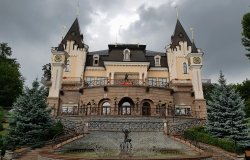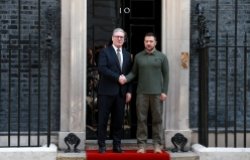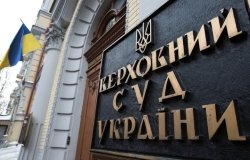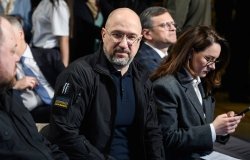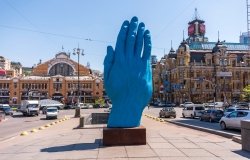
A blog of the Kennan Institute
Ukraine Quarterly Digest: April–June 2024
The below is a Kennan Institute Long Read.
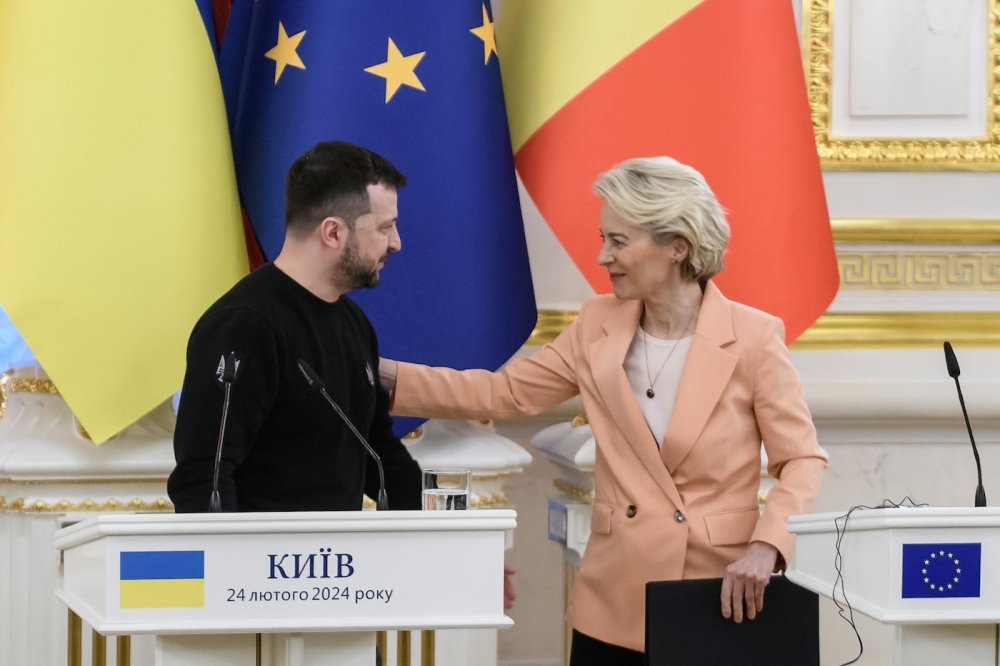
Several important international events involving Ukraine took place in the second quarter of 2024. In June, the EU officially started membership talks for Ukraine, having recognized that Ukraine has met the necessary criteria in certain areas: fighting corruption, getting political lobbying under control, forcing greater transparency around officials' wealth, and ensuring the rights of national minorities. Ukraine continued signing security cooperation agreements, including with the EU and the United States. After months of discussions, the United States passed a bill allocating $61 billion in aid for Ukraine.
New waves of Russian attacks on Ukrainian energy facilities prompted a sense of urgency among Ukraine’s allies. A key result was the consolidation of global efforts to send Ukraine more air defense means and funds and equipment to help with the renovation of the power system. Some of the allies decided to allow Ukraine to use the weapons they had provided to attack military targets in Russia. The G7 approved the use of frozen Russian assets to finance aid for Ukraine.
The situation on the front remained difficult, with intense fighting. Russia advanced a little along some parts of the front line but failed in its offensive operations in Kharkiv oblast. Russia continued its energy terrorism, and Ukraine lost huge amounts of its power generation capacities, being unable to protect them owing to a lack of air defense means and missiles.
Switzerland hosted an international peace summit that was attended by representatives from ninety-two nations, eight organizations, and one observer nation. After it concluded, Kyiv said it would develop a plan for ending the war over the next few months.
1. ROLLOUT OF THE WAR
General Developments during April–June 2024
Heavy fighting continued in the second quarter of 2024. Russian army forces applied pressure along almost the entirety of the 1,000-kilometer-long front line. With the delivery of some military aid supplies from Ukraine’s allies suspended, the Ukrainian Armed Forces (UAF) lacked the necessary weapons and munitions to mount a robust response, which led to setbacks at some critical points. According to the DeepState web service, which is not official but is based on open-source data, Ukraine lost control of 0.09 percent of its territory during these three months. A shortage of ammunition also hampered Ukraine’s ability to intercept Russian missiles. Despite the Russian army’s advantages, however, it made only limited advances on the battlefield.
Russia did partly succeed in conducting an offensive operation in Kharkiv oblast beginning May 10. However, the situation stabilized in late May, and the Ukrainian army started liberating part of the previously lost villages. Ultimately the Russian offensive operation in Kharkiv oblast failed. Ukrainian intelligence considered the Kharkiv operation an attempt to apply psychological pressure to Ukraine’s troops and civilians and to sow panic rather than to occupy the whole region.
Russia intensified its use of chemical weapons in the second quarter. Ukraine recorded 715 cases of Russian chemical weapons use on the battlefield in May, 271 more than in April. In addition, Russia started using cluster weapons to attack civilian areas.
Attacks in Russia and the occupied territories. Ukrainian forces continued attacking targets in Russia and the occupied territories, mostly Crimea. The main target in Russia remained oil infrastructure. Ukraine damaged over thirty oil refineries, fuel depots, and oil cargo terminals in Russia. In addition, Ukraine on a few occasions targeted drone storage warehouses and military airfields that Russia was using to launch airplanes that attacked Ukraine’s infrastructure. Ukrainian drones were able to reach targets located one thousand miles inside Russia.
Russia’s military facilities in Crimea were also among the key targets. Ukraine actively targeted Russian air defense forces in the second quarter. This might have been in preparation for the arrival of F-16 fighter jets. The UAF destroyed more than fifteen Russian air defense systems in Crimea during the quarter.
Russia continued losing its military ships and aircraft. The most prominent incidents were the downing of a strategic bomber, the Tupolev Tu-22M3 (Backfire), and the drone attacks on two of Russia’s most modern Su-57 fighter jets.
Engagement of Russia’s Allies
North Korean leader Kim Jong Un, during Vladimir Putin’s visit to Pyongyang, expressed support for Russia’s war against Ukraine. Russia uses North Korean missiles to strike Ukrainian cities. North Korea has continued sending munitions to Russia, and Western media have reported an increase in the shipments of these.
China has not supplied weapons to Russia. Instead, the PRC supplies Russia with machine tools, weapons technology, and satellite imagery, and in this way boosts Russia’s war machine. China refused to attend the peace summit in Switzerland if Russia was not invited.
Russian Disinformation Campaigns and Cyberattacks
Russia continued its disinformation operations and cyberattacks, designed to spread mistrust among Ukrainian citizens of Kyiv, induce fatigue, and decrease support for Ukraine on the part of allies and Western societies. Russia has stepped up its disinformation campaign against President Zelensky: as of May 20, Zelensky’s five-year term under other circumstances would have ended, and Russia has sought to persuade Ukrainians that Zelensky was holding on to power illegitimately.
This is not the case. Holding elections is technically impossible during the war, and according to polls, 70 percent of respondents believe Zelensky should continue to act as a president by the end of the war, which makes him a legitimate president.
Russia continued spreading disinformation through social media, mostly Telegram messenger; disseminating deep fake videos and propaganda videos rife with disinformation; and attempting to hack accounts and devices owned by military servants. Russia has not backed off spreading disinformation about Ukraine in Europe.
Russia did start more actively leaking false information about upcoming wide-scale offensive operations to pressure Ukrainians psychologically. The same disinformation was amplified by Belarus, which also put out stories that Ukraine was amassing weapons and units on the border.
Energy Terrorism and Other Attacks on Critical Infrastructure
Russia continued attacking critical infrastructure in the second quarter of the year, with energy facilities being the key targets. The lack of air defense missiles and hence the inability to adequately protect energy facilities were the key reasons for huge losses in the energy system.
From March 22 until late June, Russia conducted seven wide-scale attacks and a host of smaller ones on Ukraine’s power system. As a result, the system lost more than 9 GW of installed capacity, which is more than half of winter peak demand. All thermal power plants and some big hydropower plants were destroyed or damaged. Russian missiles also targeted some of the big solar power plants. Russia continued attacking fuel depots, with the total number reaching fifty targeted since the start of the full-scale invasion.
In April, Russia started attacking underground gas storage facilities with cruise and supersonic missiles, which had not happened before. Ukraine's storage facilities have the biggest capacity in Europe; they are drawn on not only by Ukrainian companies but also by European ones. Gas storage facilities are necessary to meet natural gas demand in winter, with the stored supplies covering about half of the gas consumed. Hence the attacks may pose additional risks to gas and heat supplies in winter.
In June the International Criminal Court in The Hague issued arrest warrants for former Russian defense minister Sergei Shoigu and Valery Gerasimov, who were charged with committing international crimes for their role in the missile strikes on Ukraine’s electric infrastructure from at least October 10, 2022, to at least March 9, 2023.
Crimes against Civilians and Attacks on Civilian Infrastructure
Russia ramped up its attacks on civil infrastructure and residential buildings to an even greater degree in the second quarter. In May, the number of civilian casualties hit the highest point in almost a year. The main reason for the high number of civilian casualties is the use of air-dropped bombs and missiles in populated areas, such as communities near the front line and Kharkiv city. Civilians in Kharkiv city and in some areas of Sumy oblast continued to experience Russian air attacks in the spring.
In addition to attacks on residential buildings, which have become a normal part of Russian aggression, civilian targets with a high concentration of noncombatants were hit. The most tragic such incidents involved a university and a hospital in Chernihiv, a construction mall and a book printing house in Kharkiv, and the postal service’s sorting depot in Odesa. On some days, dozens of infrastructure objects came under attack from Russian drones and missiles.
More frequently, Russian forces intensified their double attacks (double-tap tactics), which entail hitting an object, then hitting it again a short time later, after rescuers and other emergency personnel have arrived on the scene and started clearing debris, putting out fires, and looking for survivors in the rubble. Russian double-tap attacks have killed at least ninety first responders since April 2022. The Russians have increased the use of FPV drones against civilians in the front-line regions.
At least 12,000 civilians have been killed since the wide-scale invasion began in February 2022.
POW Exchanges
A small number of Ukrainian POWs, fewer than 200, were returned home during the second quarter, and since the beginning of the year in general. Photographs and videos show the poor condition of the Ukrainian POWs, some of whom have testified to torture and sexual violence. All 75 POWs who were exchanged on May 31 testified they were tortured by the Russians. Ukraine's human rights commissioner said that Moscow’s statements about being ready for an all-for-all POW exchange are manipulative and not true.
2. INTERNATIONAL AFFAIRS
The Peace Summit
In mid-June, Switzerland hosted a High-Level Summit for Peace for Ukraine, during which representatives of more than ninety countries and eight organizations discussed three major aspects of Ukraine’s ten-point peace plan: nuclear safety, food security, and prisoner swaps. Representatives of eighty-two states signed the joint communiqué. Some refused for different reasons, mostly trying to save relations with both warring parties.
The summit’s declaration stated that Ukraine’s territorial integrity must form the basis of any peace agreement and that the Zaporizhzhia Nuclear Power Plant must operate safely and securely under the full sovereign control of Ukraine. The declaration also called for the end of attacks on Ukraine’s ports, to allow exports and help guarantee global food security, and the complete exchange of civilians and prisoners.
Before the peace summit, there was some international discussion regarding Russia's possible participation. China and Saudi Arabia were the main voices arguing that Russia should join the talks. In the end, Russia was not invited. The Swiss government intends to discuss the summit's outcomes with the countries that did not attend, including Russia and China.
After the summit, President Volodymyr Zelensky stated that work on holding a second peace summit continues and that it will take place within months, not years, thus signaling that he expects an end to the war. Ukraine’s foreign minister, Dmytro Kuleba, stated that Russia’s participation might be possible indirectly, through mediators, as happened with the Black Sea Grain Initiative.
Joint Efforts to Renovate Damaged Energy and Other Infrastructure
As Russia renewed its energy terrorism and Ukraine lost a huge share of its power generation capacities, Ukraine’s partner countries stepped up efforts to help Ukraine restore and strengthen the power supply. Moving quickly is necessary for people to pass the winter safely and to get the economy on a better footing.
This topic was a main focus of the Ukraine Recovery Conference held in Berlin in June. The United States committed to granting Ukraine $0.5 billion to repair energy infrastructure and to expand power generation. Other G7 countries committed to granting another half a billion. The European Bank for Reconstruction and Development allocated €300 million to restore Ukraine's energy sector.
Earlier, the Baltic States and Germany had committed to granting equipment from the closed thermal power plants, as Ukraine lacks the parts and equipment needed to repair the damaged facilities. Austria, Belgium, Denmark, France, Germany, Italy, Latvia, and Norway, among others, announced aid packages to help the Ukrainian energy sector.
Despite the responses of Ukraine’s Western partners to the emergency situation with respect to energy infrastructure, the promised aid may not be sufficient to renovate capacities by winter.
Joint European Efforts to Arm Ukraine
Permission to attack military targets in Russia. In the second quarter, some of the allies softened their attitudes toward Ukraine using weapons they had supplied to attack military targets inside Russia. In late May, the NATO Parliamentary Assembly called on member states to allow this change in position, with many states agreeing.
Sweden was the first country to allow its weapons to be used on targets inside Russia, followed shortly by the Baltic states, the Czech Republic, Finland, France, Germany, the Netherlands, Poland, and the United States. Top officials in some other countries expressed their support for such permission. The change of heart was probably induced by Russia’s constant barrage of air attacks on critical infrastructure and civil objects inside Ukraine, along with Kyiv’s diplomatic efforts.
Air defense coalition. Germany organized an international coalition to supply Ukraine with more air defense means, with several states expressing their readiness to finance supplies. Germany itself announced granting Ukraine one more Patriot and one more IRIS-T air defense system. With this latest transfer, Germany has now sent Ukraine a quarter of its Patriot systems. Romania also agreed to grant Ukraine one Patriot system, as did the Netherlands. Italy committed to supplying one more SAMP/T installation. The United States, in addition to sending Ukraine Patriot missiles as part of the defense package, as the media reported, will also send one more installation.
In June, Ukraine received the first batch of artillery rounds under the Czech initiative, which was announced in February. The initiative prescribes buying 1.5 million rounds from non-EU states using funds provided by Western states. A shortage of munitions over the past several months significantly weakened Ukraine’s ability to respond to Russian attacks.
Transferring Frozen Russian Assets for Ukraine
On June 13, the G7 leaders approved a plan to provide Ukraine with a $50 billion loan to be repaid out of the interest on slightly less than $300 billion Russian Central Bank assets frozen in Western banks after the invasion in 2022. As constructed, the deal would be a nonrepayable grant to Ukraine rather than a loan. The funds should be transferred by the year's end or in early 2025. The details are still being worked out, but as of now, it is reported that the funds could be used for different purposes: military, budget, reconstruction, and humanitarian support.
The EU also approved €1.4 billion in military aid to Ukraine from frozen Russian assets, to be used for the direct purchases of ammunition and equipment such as aerial defense systems.
Security Cooperation Agreements
Ukraine continued signing agreements on security cooperation with other states, a process that started in early 2024. These agreements do not spell out specific guarantees or steps the signatories should take to ensure Ukraine’s sovereignty but stipulate formats for cooperation on defense and granting military aid to Ukraine. During the second quarter, Ukraine signed agreements with the EU, Belgium, Estonia, Finland, Iceland, Japan, Latvia, Lithuania, Norway, Portugal, Spain, Sweden, and the United States.
Relations with the United States and Canada
On April 20, after half a year of debates and foot-dragging, the U.S. Congress finally passed a bill for $61 billion in aid for Ukraine. The U.S. Senate then passed it without delay, and President Joe Biden signed it. The first aid package was announced shortly thereafter. This finally released the aid supply that Ukraine has needed so much over the past several months of Russian attacks on the energy infrastructure and civilian facilities. However, the actual supplies did not arrive quickly. Later, the United States also allocated $1.5 billion to Ukraine for energy and humanitarian support.
U.S. secretary of state Antony Blinken paid a surprise visit to Kyiv in May. He stressed America's long-term commitment to Ukraine's security. In addition to meeting with top officials, Secretary Blinken met with activists, students, and business representatives. Key topics at these meetings were battling corruption, reform, and the future of Ukraine.
Canada continued to be among Ukraine’s key supporters, granting military aid. In April the Ukrainian parliament ratified an updated Canada-Ukraine free trade agreement.
Relations with the EU and the European States
On June 25 the EU officially started membership talks for Ukraine and Moldova. Shortly before, the main talking points of the negotiating framework for the countries’ accession were approved. Ukraine has met the necessary criteria in certain areas: fighting corruption, getting political lobbying under control, forcing greater transparency around officials' wealth, and ensuring the rights of national minorities. Kyiv says Ukraine will be fully prepared for membership by 2030.
President Zelensky visited Brussels on June 27 to sign the EU-Ukraine security agreement. The agreement represents a commitment of all twenty-seven member states to provide Ukraine with broad support despite any internal institutional changes. The EU Council had previously approved the text. In June, Ukraine signed a €27 billion loan agreement with the EU under the Ukraine Facility program, which stipulates that Ukraine must continue carrying out reforms in different spheres as a condition for receiving funds.
The Netherlands. A new coalition government in the Netherlandsreaffirmedthe country’s support for Ukraine. The Netherlands was one of the key aid providers to Ukraine. There was a fear that after the far-right PVV party, led by Geert Wilders, won the elections, the country would stop supporting Ukraine, based on statements made by Wilders in the run-up to the elections. The country continued supplying Ukraine with crucially important weapons, including an air defense Patriot system. The country’s defense minister visited Kyiv in June to discuss military cooperation.
The Nordic and Baltic states. These states remain important supporters of Ukraine. In the second quarter they continued to allocate aid and weapons. Danish prime minister Mette Frederiksen visited Ukraine, met President Zelensky in Lviv, and signed a ten-year agreement on security assistance for Ukraine. Denmark and Ukraine later signed a memorandum on arms purchases from Ukrainian manufacturers. Sweden, among other assistance, in its largest aid package is giving Ukraine two ASC 890 airborne early warning and control (AEW&C) aircraft to identify targets at long range.
In April, Ukrainian prime minister Denys Shmyhal visited Estonia and Lithuania, meeting top officials of these states and President of Latvia Edgars Rinkevics. Military support and aid to repair power plants were among the key topics of the meetings.
France, Germany, and theUK. These countries are among Ukraine’s most important supporters. The UK has announced its biggest aid package for 2024, increasing the previously allocated amount. German vice chancellor Robert Habeck, foreign minister Annalena Baerbock, and defense minister Boris Pistorius visited Ukraine during the second quarter to discuss aid and cooperation.
President Zelensky’s Diplomatic Tours
President Zelensky continued visiting these states as part of his ongoing effort to gain support for Ukraine in fighting Russia’s war of aggression. During some of the visits, the above-mentioned security cooperation agreements were signed.
During his visit to the Czech Republic, Zelensky discussed tightening cooperation in the defense sector with his counterpart, Petr Pavel. He attended the Three Seas Initiative Summit in Lithuania in mid-April; the Shangri-La Dialogue security conference in Singapore at the beginning of June, immediately after attending the Nordic-Ukrainian summit in Stockholm on May 31; and the G7 Summit in Italy in mid-June.
He also visited Qatar on June 5 to discuss the return of kidnapped Ukrainian children (Qatar has served as an intermediary with Russia in this matter), and Saudi Arabia to discuss peace formula negotiations in advance of the upcoming June15–16 peace summit in Switzerland.
Progress in Solving the Blockade of Polish-Ukrainian Border-Crossing Points
In late April, Polish farmers unblocked all checkpoints at the Ukraine border, ending a months-long blockade. Some occasional blocks took place later, but the situation seemed to have stabilized as of the end of June.
Many analysts expected the protests to vanish in May, as local elections in Poland had concluded. The protests emerged from Polish farmers’ fears that Ukrainian grain transited through Poland would reduce the prices paid for Polish grains, but they were also driven by politics. Poland announced at the end of April that it would pay about $540 million in subsidies to farmers to compensate for low grain prices.
In June, Ukraine and the EU extended the freight liberalization agreement for one more year, with the possibility of further extensions with updates to the agreement. The agreement allows “permit-free entry of Ukrainian cargo to the EU” and proved critical in providing a pathway for Ukraine to export grain and produce after Russia blocked the Black Sea route. (Ukraine has since partially unblocked Black Sea shipping routes through its strikes on the Russian Black Sea Fleet, notably freeing up the port of Novorossiysk. Almost one-third of the Black Sea Fleet has been destroyed in the war.)
The freight liberalization regime caused protests among some European carriers, who believed the permit-free regime would undercut their prices and so blocked borders in protest. The agreement’s updates are intended to prevent misunderstandings between transporters of Ukraine’s and European countries’ goods and agricultural products.
3. INTERNAL AFFAIRS
The Energy Situation
Ukraine lost more than 9 GW of power-generating capacities in the springand early summer, which is more than half of the peak demand in winter, making the energy situation difficult. After sixteen months of unrestricted power supply, the transmission system operator was urged to restrict consumption with scheduled and emergency power cutoffs nationwide in May. Long power cutoffs are expected to last until late July.
However, the situation may be much more difficult in the coming winter. To a large extent, how it shapes up will depend on potential strikes, Ukraine’s ability to protect energy facilities with air defense means, and the progress made in constructing new facilities and repairing damaged ones. By any measure, however, the coming winter will be more difficult than the winter of 2022–2023 with respect to energy availability.
From June 1, the government increased household electricity prices by 63 percent. This was the second rise in electricity prices during the full-scale invasion. The previous one took place a year before, when household electricity prices increased by more than 70 percent. These increases mean that the electricity tariff now covers the cost of production and supply.
Energy prices have always been a sensitive issue in Ukraine, and politicians have used them for political ends for decades. However, the economic crisis and huge losses in the energy sector, both outcomes of Russia’s military aggression, deeply complicate further state subsidization of the tariff.
The Economic Situation
Electricity shortages and cutoffs have affected the country’s economy, leading the National Bank of Ukraine (NBU) to revise its forecasts of GDP growth. It now predicts 3 percent growth for the year, compared to the 3.6 percent expected earlier. In 2023, real GDP growth amounted to 5.3 percent.
Slowing inflation again led the NBU to decrease its key rate by 0.5 percent twice, to 13 percent. At the same time, state budget revenues have been falling for four months in a row, from February through May. Foreign currency reserves have also decreased, amounting to around $39 billion at the beginning of June.
Government Reshuffles
Several significant governmental reshuffles took place during the quarter. In April, Ukraine’s parliament dismissed the agrarian minister, Mykola Solskyi, whom the National Anti-Corruption Bureau had earlier accused of illegally acquiring state-owned land in 2017.
In May, parliament dismissed Oleksandr Kubrakov, infrastructure minister and deputy prime minister for reconstruction. Mustafa Nayyem, the head of Ukraine's Agency for Restoration and Infrastructure Development, resigned in June.
Though the formal reason given for Kubrakov’s dismissal was failure to implement regional policy, these last two departures underscore the difficulty of administering government programs during wartime, especially those concerned with infrastructure relentlessly targeted by the enemy. Kubrakov and Nayyem were responsible for shelter construction to protect energy facilities from shelling, and spent billions in the effort. Both were hindered in their efforts, as the energy system incurred huge losses starting at the end of March. And it is clear that no amount of infrastructure hardening can protect a huge power plant from missiles.
Amended Legislation on Army Mobilization
In mid-April, parliament passed a new law on army mobilization that amended numerous other laws. It broadens the scope of who may be mobilized and replenishes the ranks of reserves.
The opinions expressed in this article are those solely of the author and do not reflect the views of the Kennan Institute.
See our newest content first.
Subscribe to receive the latest analysis from Focus Ukraine.
About the Author

Andrian Prokip
Director, Energy Program, Ukrainian Institute for the Future

Kennan Institute
The Kennan Institute is the premier US center for advanced research on Eurasia and the oldest and largest regional program at the Woodrow Wilson International Center for Scholars. The Kennan Institute is committed to improving American understanding of Russia, Ukraine, Central Asia, the South Caucasus, and the surrounding region though research and exchange. Read more




